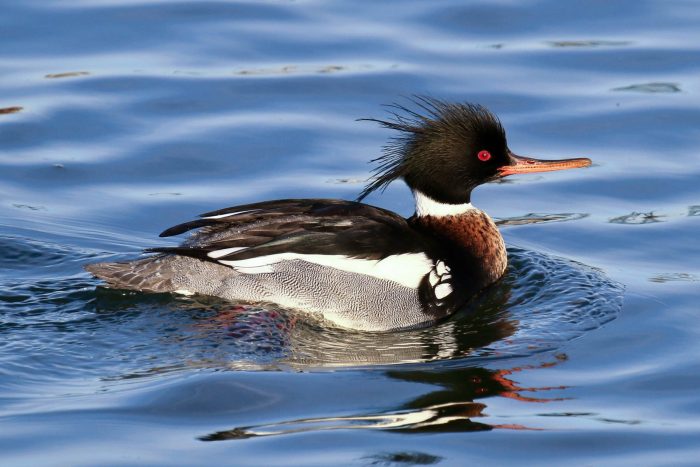Red-Breasted Merganser
Mergus serrator
The red-breasted merganser is a diving duck with a long, serrated bill and a shaggy crest on the back of the head. It lives along the shores of the Chesapeake Bay and its tidal creeks and rivers from autumn through spring.
This section shows one large critter image at a time. Use the thumbnails that follow to select a specific image to display here.

This gallery contains a grid of small thumbnails. Selecting a thumbnail will change the main image in the preceding section.
Appearance
The red-breasted merganser has a shaggy crest on the back of the head and a long, slender, reddish-orange bill with serrated edges. White patches, called specula, appear on its wings. Males and females have different patterns and coloring. Males have a greenish head; a white collar; a reddish-brown chest; and gray sides. Females have a reddish-brown head and neck, and a shorter crest and lighter chest than males. These ducks grow 20 to 25 inches in length.
Feeding
The red-breasted merganser eats mostly fish such as killifish, menhaden and anchovies. It hunts in mixed gender groups in the Bay’s shallows; groups herd schools of fish and then feed on them underwater. It uses its unique serrated bill to catch slippery fish underwater
Predators
Humans hunt red-breasted mergansers. Owls and red foxes may prey upon adults, while minks, gulls and ravens prey upon eggs and young on their breeding grounds.
Flight
This duck takes off by running across the water’s surface and flapping its wings. They fly in a single-file line very low over the water. In flight, all mergansers hold their bill, head, body and tail straight and can be identified by their white wing patches, long reddish bill and white neck (on males).
Voice
Red-breasted mergansers are usually silent in winter, when it is not breeding season. During courtship rituals, males may make a yeow-yeow sound, and females may respond with a raspy krrrr-krrrr.
Reproduction and life cycle
These birds do not reproduce in the Bay region, but nest and breed from the Great Lakes to the Arctic. They return to the same nesting site every year. Only 50 percent of all red-breasted mergansers are believed to survive winter and migration each year. They can live as long as nine years.
Did you know?
- Red-breasted mergansers are very active swimmers that can swim well both above and below the water’s surface. Like other diving ducks, red-breasted mergansers are awkward on land because their legs are located far back on their body.
- They can stay underwater for as long as 44 seconds.
Sources and additional information
- Life in the Chesapeake Bay by Alice Jane Lippson and Robert L. Lippson
- Chesapeake Bay: Nature of the Estuary, A Field Guide by Christopher P. White
- Animal Diversity Web: Mergus serrator – University of Michigan Museum of Zoology
- Waterfowl ID: Red-breasted Merganser – Ducks Unlimited
- All About Birds: Red-breasted Merganser – The Cornell Lab of Ornithology
